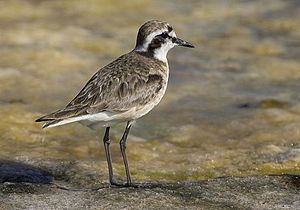Shepherd's Ringed Plover
| Shepherd's Ringed Plover | ||||||||||
|---|---|---|---|---|---|---|---|---|---|---|

Shepherd's plover in magnificent summer dress, West Coast National Park, South Africa |
||||||||||
| Systematics | ||||||||||
|
||||||||||
| Scientific name | ||||||||||
| Charadrius pecuarius | ||||||||||
| Temminck , 1823 |
The Kittlitz's Plover ( Charadrius pecuarius ) is a species of the family of Plover and in Africa the southern Sahara and on Madagascar and in the Nile Delta to be found, where it occurs year-round in some areas and only seasonally occurs in different regions.
description
The long-legged shepherd's plover is 14 to 16 cm long and slightly smaller than a Kentish plover . The wing length is between 98 and 106 mm, the weight is just under 50 g.
In the magnificent dress , the back and top are gray-brown and have a washed-out pattern thanks to dark feathers and lighter hems. The pale orange color of the breast slowly fades towards the whitish underside. The under tail-coverts are white. The head is predominantly white, the parting very high above the white forehead is gray-brown. A wide, white stripe over the eyes merges into a wide band at the nape of the neck. A black band runs across the forehead towards the eye. The reins, eye and cheek stripes are also black. A black band runs over the sides of the neck and goes in the neck in a black line over which the white neck band separates from the back. The legs are dark gray.
In winter, the adult birds lose their unmistakable facial pattern and resemble the Kentish plover, but retain their pale-orange breast coloration.
The coloring of the young resembles the winter dress of adult birds. The pale orange color is limited to a chest band and can also be seen on the sides of the head.
Habitat and way of life
The shepherd's ringed plover prefers open, grassy shorelines of inland waters, especially of flat salt pans , but also occurs (albeit less often) on the coast of the sea. The shepherd's plover also occurs on the short-cut grass areas of sports fields or on airfields. He looks for insects , worms , crabs and mussels in daylight on open grassy areas or in the dry mud of the bank areas . The shepherd's plover, along with the pale ringed plover, is one of the few species that occur in the area of the Makgadikgadi salt pans all year round and therefore also during the dry season.
Outside the breeding season, the species lives singly or gregariously in loose groups. Flocks of up to 250 birds can be found on migrations.
Wetlands International has identified twelve regions that are considered to be significant breeding or resting places of this species because they each contain more than one percent of the population. These include Lake Turkana in Kenya, Lake Manzala in northeast Egypt, Abijatta in Ethiopia and Lac Alaotra and Lac Ihotry in Madagascar.
Reproduction
The breeding season extends from March to September, in Zimbabwe preferably in September, in the Transvaal mainly from July to October and in Natal mainly from May to October. The shepherd's plover breeds in loose colonies in the open field. The simple nests are padded with earth and grass and sometimes only a few meters apart.
As a rule, each breeding pair incubates 2 greenish yellow eggs with thin, black wavy lines and spots, from which the chicks hatch after an incubation period of 23 to 27 days. The male breeds mainly at night and the female during the day. The young birds fledge after about 30 days.
Internal system
The division of the species into subspecies is still disputed. Basically, however, the shepherd plovers that inhabit an area around the equator are generally smaller than the birds that can be found in more temperate zones to the north and south of it. The proposed subspecies includes the subspecies Charadrius pecuarius allenbyi (Nicoll 1921) for the shepherd's plovers , which occur in the Nile Valley as far as Luxor, and the subspecies Charadrius pecuarius isabellinus (Clancey 1971), which occur from Egypt to the Democratic Republic of the Congo. It has also been suggested to assign the plover breeding in Madagascar to a separate subspecies (Hayman et al., 1986). Basically, however, the differences between the individual populations are small and the transitions are fluid.
designation
The common English name Kittlitz's Plover goes back to the German officer and ornithologist Friedrich Heinrich Freiherr von Kittlitz , who observed and described the shepherd 's plover in 1831, after the first description by Coenraad Jacob Temminck , on the way back from a trip to Africa in Egypt .
supporting documents
literature
- Einhard Bezzel: birds. BLV Verlagsgesellschaft, Munich 1996, ISBN 3-405-14736-0
- Simon Delany, Derek Scott, Tim Dodman, David Stroud (Eds.): An Atlas of Wader Populations in Africa and Western Eurasia. Wetlands International , Wageningen 2009, ISBN 9789058820471
- L. Svensson, PJ Grant, K. Mularney, D. Zetterström: The new cosmos bird guide. Franckh-Kosmos Verlags-GmbH, Stuttgart 1999, ISBN 3-440-07720-9
- GL MacLean, A. Roberts: Roberts' Birds of Southern Africa. Southern African Birding cc., 1997-2003, ISBN 0620340533
Web links
- Charadrius pecuarius inthe IUCN 2013 Red List of Threatened Species . Listed by: BirdLife International, 2013. Retrieved December 7, 2013.
- Pictures of the Shepherd's Plover by Trevor Hardaker

